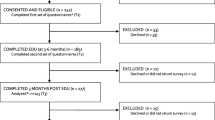Abstract
Identification of barriers to seeking health care for a concerning mole found during skin self-examination (SSE) by women educated during screening mammography. In this sequential mixed methods research, interviews with women who found a concerning mole and did not have health-care follow-up were analyzed and a survey was created. One year after SSE education, barriers to having health care for a self-identified concerning mole were assessed. The electronic medical records for all participants, who received education, were reviewed to ascertain who received health care related to a concerning mole or a screening mammogram. Among the 280 women who performed SSE, 85 found a concerning mole. Nine months later 51 women did not receive health care for the mole. Barriers were the burden of other medical concerns, fear of what the doctor will find, feeling like nothing is wrong, and being too busy. A positive screening mammogram (Fisher’s two-sided exact test, p < 0.001) and a history of indoor tanning (Fisher’s two-sided exact test, p = 0.011) were significantly associated with lack of follow-up for a concerning mole. Targeted melanoma self-identification with SSE relies upon participants initiating performance and seeking medical care for a concerning mole. The burden of a positive screening mammogram reported to women at about the same time as they identified the concerning mole was associated with failing to seek care for their concerning mole. Reminders to check moles for change 4 months after identifying a concerning mole may benefit women. Clinicaltrials.gov NCT03512457
Similar content being viewed by others
References
Robinson JK, Wayne JD, Martini MC, Hultgren BA, Mallett KA, Turrisi R (2016) Early detection of new melanomas by patients with melanoma and their partners using a structured skin self-examination skills training intervention: a randomized clinical trial. JAMA Dermatol 152(9):979–985
Robinson JK, Perez M, Abou-el-Seoud D et al (2019) Skin self-examination education for melanoma during mammography for women. JNCI Cancer Spectrum 3(3):1–8
Weinstock MA, Martin RA, Risica PM, Berwick M, Lasater T, Rakowski W, Goldstein MG, Dubé CE (1999) Thorough skin examination for the early detection of melanoma. Am J Prev Med 17(3):169–175
Kamińska-Winciorek G, Gajda M, Wydmański J, Tukiendorf A (2015) What do web users know about skin self-examination and melanoma symptoms? Asian Pac J Cancer Prev 16(7):3051–3056
Manne S, Fasanella N, Connors J, Floyd B et al (2004) Sun protection and skin surveillance practices among relatives of patients with malignant melanoma: prevalence and predictors. Prev Med 39(1):36–47
Robinson JK, Fisher SG, Turrisi RJ (2002) Predictors of skin self-examination. Cancer. 95:135–146
Boniol M, Autier P, Boyle P, Gandini S (2012) Cutaneous melanoma attributable to sunbed use: systematic review and meta-analysis. BMJ. 345:e4757
Fears TR, Sagebiel RW, Halpern A, Elder DE et al (2011) Sunbeds and sunlamps: who used them and their risk for melanoma. Pigment Cell Mel 24:574–581
Keating NL, Pace LE (2018) Breast cancer screening in 2018: time for shared decision making. JAMA. 319(17):1814–1815
Johnson MM, Leachman SA, Aspinwall LG, Cranmer LD, Curiel-Lewandrowski C, Sondak V et al (2017) Skin cancer screening: recommendations for data-driven screening guidelines and a review of the USPHSTF controversy. Melanoma Manag 4:13–37
Rzepecki AK, Jain N, Ali Y et al (2017) Promoting early detection of melanoma during the mammography experience. Int J Women’s Dermatol 3(4):195–200
Gathirua-Mwangi W, Cohee A, Tarver WL, Marley A, Biederman E, Stump T, Monahan P, Rawl S, Skinner CS, Champion VL (2018) Factors associated with adherence to mammography screening among insured women differ by income levels. Womens Health Issues 28(5):462–469
Katz ML, Reiter PL, Young GS, Pennell ML, Tatum CM, Paskett ED (2015) Adherence to multiple cancer screening tests among women living in Appalachia Ohio. Cancer Epi Biomark Prev 24(10):1489–1494
Elo S, Kyngäs H (2008) The qualitative content analysis process. J Adv Nursing 62(1):107–115
Hsieh H-F, Shannon SE (2005) Three approaches to qualitative content analysis. Qual Health Res 15(9):1277–1288
Charmaz K 2006 Constructing grounded theory: a practical guide through qualitative analysis.London; Thousand Oaks, Calif.: Sage Publications
Braun V, Clarke V (2006) Using thematic analysis in psychology. Qual Res Psychol 3(2):77–101
Sweeny K, Christianson D, McNeill J (2019) The psychological experience of awaiting breast diagnosis. Ann Behav Med 53(7):630–641
Schonberg MA, Silliman RA, Ngo LH, Birdwell RL, Fein-Zachary V, Donato J, Marcantonio ER (2014) Older women’s experience with a benign breast biopsy-a mixed methods study. J Gen Intern Med 29(12):1631–1640
Schacter DL (1999) The seven deadly sins of memory: insights from psychology and cognitive neuroscience. Am Psychol 54:182–185
Redelmeier DA, Katz J, Kahneman D (2003) Memories of colonoscopy: a randomized trial. Pain. 104:187–194
Acknowledgments
Namita Jain, MD, Department of Dermatology, Northwestern University, Feinberg School of Medicine, assisted with thematic analysis of the transcripts of interviews with women who did not make an appointment for a concerning mole with a health-care provider. Elizabeth L. Gray, MS, Biostatistics Collaboration Center, Department of Preventive Medicine, Northwestern University performed the statistical analysis.
Funding
This research was supported by Gail Elden, in memory of Richard Elden. Research reported in this publication was also supported by the National Cancer Institute R01CA154908.
Author information
Authors and Affiliations
Corresponding author
Ethics declarations
Conflict of Interest
The authors declare that they have no conflicts of interest.
Disclaimer
The content is solely the responsibility of the authors and does not necessarily represent the official views of the National Institutes of Health.
Additional information
Publisher’s Note
Springer Nature remains neutral with regard to jurisdictional claims in published maps and institutional affiliations.
Rights and permissions
About this article
Cite this article
Robinson, J.K., Brown, Z. & Spring, B. Melanoma Skin Self-Examination Education During Mammography: Health Burden of Women Impairs Implementation. J Canc Educ 36, 858–864 (2021). https://doi.org/10.1007/s13187-020-01714-4
Published:
Issue Date:
DOI: https://doi.org/10.1007/s13187-020-01714-4




